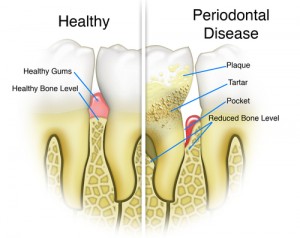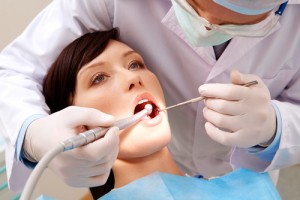How to Treat Gum Disease
 Gum disease, also called periodontal disease or gingivitis, is a very common, yet concerning, disease that affects over 64.7 million Americans over the age of 30, according to the American Academy of Periodontology.
Gum disease, also called periodontal disease or gingivitis, is a very common, yet concerning, disease that affects over 64.7 million Americans over the age of 30, according to the American Academy of Periodontology.
Studies have shown a strong link between gum disease and other inflammatory diseases, such as diabetes, heart disease, and rheumatoid arthritis. When these diseases are already present, gum disease can spur their progression. Gum disease can also lead to tooth and gum sensitivity as well as tooth loss.
Many believe that poor oral hygiene is the only cause of gum disease, but several factors can also increase your risk, including tobacco use, stress, poor diet, hormonal changes, certain medications, and even genetics. Since the symptoms of gum disease are not always easy to detect, it is very important to visit your dentist regularly. By the time you are able to see and feel the effects of gum disease, it is already quickly becoming a hazard to your health.
Dr. Fiss has received extensive training on the diagnosis, treatment, and prevention of periodontal disease.
Diagnosis
Symptoms of gingivitis include gums that are red, sensitive, and bleed easily. The disease can usually be reversed with daily brushing and flossing or with a professional cleaning from your dentist or dental hygienist. However, if left untreated, gingivitis can lead to the more serious stage of gum disease called periodontitis, which means “inflammation around the tooth.”
With periodontitis, the gums will pull away from the teeth and form deep pockets that can become infected. As plaque spreads below the gum line, the immune system will begin to break down precious bone and tissue that hold the teeth in place. Eventually, the teeth may become loose or completely fall out.
Treatment
 Dr. Fiss uses the most advanced form of laser-assisted treatment to cure gum disease. The very small fiber-optic tip of the laser is inserted into the top of the pocket between the gum and the tooth to remove the diseased tissue. The laser will selectively target and eliminate only the diseased tissue and germs, dissolving toxins and leaving the healthy tissue unharmed. Ultrasonic cleaners are then used to remove tartar and calcium deposits from the tooth’s surface. The laser is used again at the bottom of the pocket to remove any remaining diseased tissue, completely eliminating bad bacteria, germs, and toxins. This also stimulates the formation of a blood clot, which, once formed, contains fibers that re-attach gum tissue to the tooth’s surface and seal out debris and bacteria just like stitches would. This creates the right environment for bone and other soft tissues lost from the disease to grow back.
Dr. Fiss uses the most advanced form of laser-assisted treatment to cure gum disease. The very small fiber-optic tip of the laser is inserted into the top of the pocket between the gum and the tooth to remove the diseased tissue. The laser will selectively target and eliminate only the diseased tissue and germs, dissolving toxins and leaving the healthy tissue unharmed. Ultrasonic cleaners are then used to remove tartar and calcium deposits from the tooth’s surface. The laser is used again at the bottom of the pocket to remove any remaining diseased tissue, completely eliminating bad bacteria, germs, and toxins. This also stimulates the formation of a blood clot, which, once formed, contains fibers that re-attach gum tissue to the tooth’s surface and seal out debris and bacteria just like stitches would. This creates the right environment for bone and other soft tissues lost from the disease to grow back.
Prevention
The best way to prevent gum disease is to brush and floss your teeth regularly and to visit your dentist at least twice a year for a thorough cleaning and examination.
If you suspect you have gum disease or if you would like to schedule a cleaning, please call (312) 642-6631 today. For your convenience, you may also fill out our quick contact form.